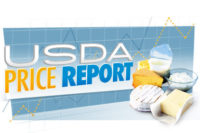
While U.S. dairy processors can find eager buyers abroad, there is work to do at home to develop products and marketing messages to appeal to the American consumer.
As a follow-up to a study conducted in 2008 of the export market, Boston-based Bain & Co. stated that its recent analysis “showed that long-term demand for dairy products will remain strong, driven primarily by emerging markets.”
“At the same time, traditional sources of supply are constrained and will fall short of expected needs,” says Clinton Anderson, a partner with Bain & Co. “In fact, the demand gap is likely wider than anticipated a few years ago, and the window of opportunity remains open, with the United States well-positioned as a supplier to take advantage.”
A second study, this one by a Swiss-based equipment and packaging firm, concluded that “the world is set for a decade-long boom in milk consumption, with demand for liquid dairy products set to surge by around 30% from 2010 to 2020, driven by economic growth, urbanization and the rising purchasing power of Asia’s middle class.”
The forecast, by Tetra Pak, Vernon Hills, Ill., also states that by 2014, packaged milk will outsell “loose” (unpackaged) milk in the developing world for the first time.
Where the exports are going
The Innovation Center for U.S. Dairy, Rosemont, Ill., worked with the consulting firm Bain & Co. and concluded that growth prospects remain intact. The IC sought to update the research to determine if fast-changing international dairy market conditions since the 2008 global financial crisis altered the initial findings, conclusions and recommendations to the dairy industry. Over the last three years, China, India, Southeast Asia and the Middle East/North Africa have shown continued demand growth, the report noted. More than 75% of the projected increase in world non-fluid dairy consumption from 2010-15 is expected to come from these four regions.
The Tetra Pak research stated that by the end of the decade, India and China are expected to account for more than a third of the world’s total liquid dairy products consumption, with the Asia-Pacific region alone continuing to consume more than the rest of the world combined. Asia-Pacific, Latin America and Africa are all forecast to record double-digit growth in demand for liquid dairy products in 2010-2020.
The IC said that Russia’s dairy production dipped and potential low-cost producers such as Brazil and Ukraine failed to develop their supply capabilities. Other sources such as Argentina and Belarus have good potential but are relatively small. Despite modest production increases, New Zealand and the European Union will be unable to keep up with emerging market needs, the 2011 report update concludes.
80 billion more liters by 2020
Global demand for all forms of liquid dairy products (LDP) will grow from some 270 billion liters in 2010 to around 350 billion liters by 2020, according to Tetra Pak. LDP includes white milk and other liquid dairy products, such as flavored milk, drinking yogurt, sweetened condensed milk, lactic acid drinks and baby and toddler milk. In this decade, global consumption of other liquid dairy products is set to rise by close to 60%, topping 100 billion liters by 2020.
The demand for LDP will climb in every region of the world between 2010 and 2020, with the exception of Western Europe where demand is likely to remain flat. The dairy boom will be most pronounced in Asia – led by India and China – where increased prosperity and the rapid growth of the middle class will spur a significant rise in consumption among millions of consumers, according to Tetra Pak.
Demographics, economic growth and sustainability are fuelling six fundamental developments or “mega trends,” which will shape the future of the dairy value chain, Tetra Pak forecasts. Demographic change will be characterized by a growing population increasingly living in cities. Economic growth, particularly in emerging markets, will spur development, boost the ranks of the middle class and speed up globalization. Sustainability will become a key issue as demand for resources puts pressure on the environment and increases the need for technological innovation. The six resulting “mega trends” are:
1. Increased demand for packaged food
2. Greater diversification of consumer needs
3. Changing dynamics in food manufacturing and retailing
4. More food safety awareness
5. Rising competitive pressure
6. Acceleration in green solutions as a “must have” for businesses

Growth spurred by middle class
The World Bank expects the global middle class – broadly defined as those earning around $10-$20 a day – to soar from 430 million in 2000 to 1.15 billion by 2030. These new consumers are expected to show more interest in issues related to food safety, healthy living and the environment. In addition, they are likely to be more brand conscious and interested in products that meet the needs of their busy, urban, “on-the-go” lifestyles.
“The emergence of the middle class, urbanization and the expansion of modern shopping habits by busy, health conscious and well-informed consumers have raised both the consumption and distribution of packaged milk. Consumers are looking for greater convenience without compromising on quality and safety,” says Charles Brand, Tetra Pak vice president, marketing and product management.
The U.S. forecast
Plain white milk remains a big seller in mature markets, but it is value-added products promoting convenience, health and well-being that may offer the best growth opportunities, according to the Tetra Pak report. Although there is rising demand in the emerging markets, Western Europe and North America are set to remain the Top 2 markets for liquid dairy products, in terms of per capita consumption in 2020, according to Tetra Pak. The average Western Europeans and Americans will still be consuming almost 80 liters a year by 2020 compared to the approximately 45 liters consumed by Asians. Still, per capita consumption of dairy products is expected to decrease 3% in North America while rising everywhere else from 2010 to 2020.
To compensate for falling volumes, Tetra Pak advises processors to offer more value-added, individualized products to “an increasingly segmented” market. Demand for lactose-free milk, organic milk, fortified and functional milk is expected to grow with consumers increasingly proactive in safeguarding their health, particularly in developed countries where fertility rates are falling and the percentage of the population over 60 is growing. Around two-thirds of milk sold in the United States is private label. The economic downturn in that market sparked a faster drop in branded white milk sales than sales of private label milk from 2007 to 2010.
“To recover lost sales, branded companies need to go beyond the logo on their milk: they need to add value – true nutritional benefits that private labels do not offer,” says Sheniqua Little, Tetra Pak’s marketing manager, dairy and dairy alternatives for the United States and Canada.
Recommendations for staying competitive
In the original 2008 report for the IC, researchers identified a number of structural weaknesses that could prevent the United States from capitalizing on the global market opportunity. As a result, the IC board recommended a series of pre-competitive industry initiatives to help the U.S. industry improve its competitiveness and stake a position as a globally consistent supplier. Those recommendations include:
• Reform of U.S. pricing and risk management policies
• Increased access to international markets
• Improved responsiveness to serving product needs of global buyers.
The window of opportunity cited in the 2011 report update won’t remain open indefinitely, echoes Tom Suber, president of the U.S. Dairy Export Council, Arlington, Va., which manages the globalization program on behalf of the Innovation Center. Suber is a Dairy Foods contributing writer.
“As an industry, we have a limited ability to control the ‘size of the prize,’” he says. “What we can control is time – how quickly we move into this space to build a defensible, sustainable position against the inevitable emergence of new suppliers.
“Global buyers see the United States as the natural source of future supply. But they await improved U.S. policies and practices that will permit a greater reliance on the United States as a consistent global supplier rather than as a residual one,” Suber explains.
The Globalization Operating Committee will continue work programs in seven strategic areas: price risk management, quality and traceability, product standards, sales and marketing capabilities, innovation, as well as monitoring of industry efforts in pricing reform and trade treaties.
Washington Watch
Tipton’s Video Touts Simple Approach for Dairy Reform, IDFA Submits Letter Urging Congress to Pass FTAs
Growing global demand and the business it’s bringing to the United States “is a total success story for the U.S. dairy industry,” says Connie Tipton, president and CEO of the International Dairy Foods Association (IDFA), Washington, D.C. This and other topics are discussed in Tipton’s latest video, “Coffee with IDFA: Dairy Policy with Connie Tipton.”
In this 17-minute, 15-second YouTube video, Tipton emphasizes the importance of getting the right policies in place “so we can take full advantage and be a consistent exporter in these markets.”
She calls for keeping policies simple, getting rid of the Dairy Product Price Support Program, providing adequate funding for the Livestock Gross Margin for Dairy program, setting up tax-deferred savings accounts for producers and simplifying the milk pricing system.
Go to http://www.youtube.com/watch?v=9q_Q33t0ttA to view the video.
In addition to Tipton’s push for dairy reform, a coalition of more than 120 agriculture and food organizations, including IDFA, submitted a letter to Congress and President Obama emphasizing the importance of passing the pending free-trade agreements (FTAs) with South Korea, Colombia and Panama. The agreements, which feature strong benefits for dairy exports, appear to be gaining renewed momentum now that the debt-limit deadlock is over.
“It’s difficult to watch years of market development evaporate in a matter of months because we are not able to compete on the basis of price, making the United States the residual supplier where it was once the main supplier,” the coalition letter said. “U.S. agriculture is prepared to work to achieve the full benefits of these agreements but can only do so if the U.S. government moves quickly to pass these agreements.”
The agreements previously stalled over renewal of the expanded trade adjustment assistance (TAA) program, which provides financial aid and training to displaced workers. The administration said it will not submit the three agreements to Congress without reaching a deal to renew TAA, but Republicans consistently oppose combining the two. The latest reports say several leading members of Congress are currently working on solving the dispute and may be close to a deal.
“While IDFA had hoped that these important agreements would be passed before the August recess, we are optimistic that they will take a high priority when Congress meets in September,” says John Kelly, IDFA manager of international affairs. “It’s important to get these deals passed as quickly as possible because other dairy exporting countries like the European Union already have agreements with important markets, including South Korea. We are already seeing a quota disadvantage of 4,560 tons for cheese in that market.”


